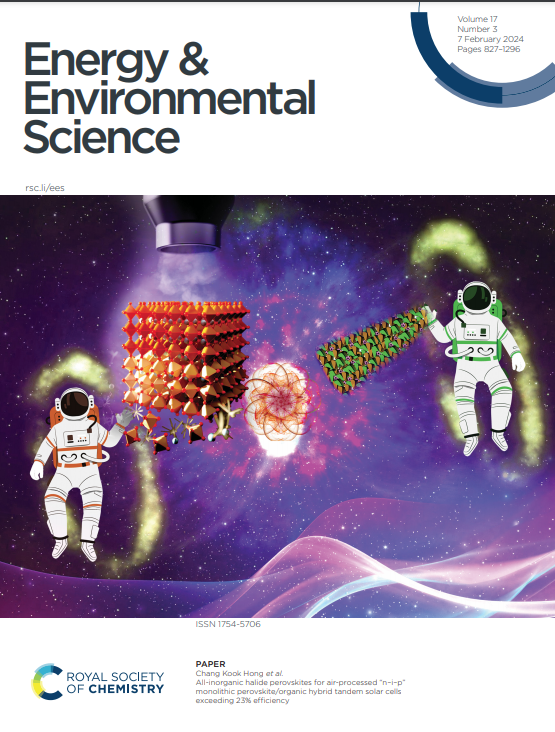Inhibiting cathode dissolution and shuttling of V-O species by a polybenzimidazole hydrogel electrolyte for durable high-areal-capacity Zn-V2O5 batteries
IF 32.4
1区 材料科学
Q1 CHEMISTRY, MULTIDISCIPLINARY
引用次数: 0
Abstract
Aqueous Zn-V2O5 batteries, renowned for their intrinsic safety and high energy density, hold significant promises for large-scale energy storage. Despite achieving impressive fast-charging performance, maintaining long-term cycling performance in practical Zn-V2O5 batteries with high areal capacities (> 2 mAh cm-2) at moderate cycling rates (< 1 C) remains a formidable challenge due to aggravated cathode dissolution issues. Herein, a polybenzimidazole (PBI) hydrogel electrolyte is developed to suppress cathode dissolution and shuttling of dissolved V-O species simultaneously. Based on advanced characterizations including in-situ X-ray diffraction and electrochemical quartz crystal microbalance, the degradation mechanism of commercial V2O5 cathode is elucidated to both chemical dissolution, triggered by active water attack and electrochemical dissolution, induced by pH fluctuation following proton intercalation. Accordingly, the unique electron cloud density distributions of PBI chains not only reduce the amount of free water by forming abundant hydrogen bonds but also minimize proton co-intercalation by transporting Zn2+ selectively. Moreover, the PBI electrolyte also effectively prevents the crosstalk of polyvanadate ions through synergistic physical barrier and chemical adsorption effects. Therefore, the Zn-V2O5 battery using PBI electrolyte demonstrate one of the best low-rate cycling stabilities reported to date (~ 2 mAh cm-2 at 0.3 C over 300 cycles), verifying its feasibility.利用聚苯并咪唑水凝胶电解质抑制阴极溶解和 V-O 物种穿梭,实现耐用的高铝容量 Zn-V2O5 电池
Zn-V2O5 水电池以其固有的安全性和高能量密度而闻名,在大规模能量存储方面大有可为。尽管实现了令人印象深刻的快速充电性能,但由于阴极溶解问题的加剧,在中等循环速率(1 C)下保持具有高面值容量(2 mAh cm-2)的实用 Zn-V2O5 电池的长期循环性能仍然是一项艰巨的挑战。本文开发了一种聚苯并咪唑(PBI)水凝胶电解质,可同时抑制阴极溶解和溶解 V-O 物种的穿梭。基于原位 X 射线衍射和电化学石英晶体微天平等先进的表征方法,阐明了商用 V2O5 阴极的降解机制,即活性水侵蚀引发的化学溶解和质子插层后 pH 值波动引起的电化学溶解。因此,PBI 链独特的电子云密度分布不仅能通过形成丰富的氢键来减少自由水量,还能通过选择性地传输 Zn2+ 来最大限度地减少质子共插。此外,PBI 电解质还能通过物理屏障和化学吸附的协同作用,有效防止聚钒酸盐离子的串扰。因此,使用 PBI 电解质的 Zn-V2O5 电池展示了迄今为止所报道的最佳低速率循环稳定性之一(在 0.3 摄氏度下循环 300 次,约 2 mAh cm-2),验证了其可行性。
本文章由计算机程序翻译,如有差异,请以英文原文为准。
求助全文
约1分钟内获得全文
求助全文
来源期刊

Energy & Environmental Science
化学-工程:化工
CiteScore
50.50
自引率
2.20%
发文量
349
审稿时长
2.2 months
期刊介绍:
Energy & Environmental Science, a peer-reviewed scientific journal, publishes original research and review articles covering interdisciplinary topics in the (bio)chemical and (bio)physical sciences, as well as chemical engineering disciplines. Published monthly by the Royal Society of Chemistry (RSC), a not-for-profit publisher, Energy & Environmental Science is recognized as a leading journal. It boasts an impressive impact factor of 8.500 as of 2009, ranking 8th among 140 journals in the category "Chemistry, Multidisciplinary," second among 71 journals in "Energy & Fuels," second among 128 journals in "Engineering, Chemical," and first among 181 scientific journals in "Environmental Sciences."
Energy & Environmental Science publishes various types of articles, including Research Papers (original scientific work), Review Articles, Perspectives, and Minireviews (feature review-type articles of broad interest), Communications (original scientific work of an urgent nature), Opinions (personal, often speculative viewpoints or hypotheses on current topics), and Analysis Articles (in-depth examination of energy-related issues).
 求助内容:
求助内容: 应助结果提醒方式:
应助结果提醒方式:


